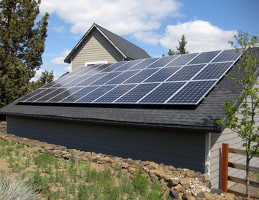Local Knowledge About Grid-Interface And Stand-Alone Systems

Because photovoltaic cells produce DC (direct current) power, systems usually include a device called an inverter, which converts the DC power to AC (alternating current) power to match it to the electric utility's power supply. Although homes can be completely "off the electric grid" (called stand-alone systems) and disconnected from the electric utility, this requires large battery systems to store the electricity produced during the day. Many homeowners prefer systems that are connected to the power grid (called grid-interface systems). In some states, electric utilities will allow the photovoltaic system to add electricity back into the power grid when the system is producing more electricity than is being used in the home. In this arrangement, called "net metering," the electric meter will literally run backwards, reducing the homeowner's electric bill. Other utilities prefer a dual-metering arrangement in which the homeowner pays one rate for the electricity you buy from the utility, and they pay you a separate rate for the electricity you sell to them.
 Because photovoltaic cells produce DC (direct current) power, systems usually include a device called an inverter, which converts the DC power to AC (alternating current) power to match it to the electric utility's power supply. Although homes can be completely "off the electric grid" (called stand-alone systems) and disconnected from the electric utility, this requires large battery systems to store the electricity produced during the day. Many homeowners prefer systems that are connected to the power grid (called grid-interface systems). In some states, electric utilities will allow the photovoltaic system to add electricity back into the power grid when the system is producing more electricity than is being used in the home. In this arrangement, called "net metering," the electric meter will literally run backwards, reducing the homeowner's electric bill. Other utilities prefer a dual-metering arrangement in which the homeowner pays one rate for the electricity you buy from the utility, and they pay you a separate rate for the electricity you sell to them.
Because photovoltaic cells produce DC (direct current) power, systems usually include a device called an inverter, which converts the DC power to AC (alternating current) power to match it to the electric utility's power supply. Although homes can be completely "off the electric grid" (called stand-alone systems) and disconnected from the electric utility, this requires large battery systems to store the electricity produced during the day. Many homeowners prefer systems that are connected to the power grid (called grid-interface systems). In some states, electric utilities will allow the photovoltaic system to add electricity back into the power grid when the system is producing more electricity than is being used in the home. In this arrangement, called "net metering," the electric meter will literally run backwards, reducing the homeowner's electric bill. Other utilities prefer a dual-metering arrangement in which the homeowner pays one rate for the electricity you buy from the utility, and they pay you a separate rate for the electricity you sell to them.